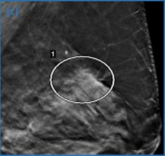The World Health Organization reports that breast cancer affects approximately 2.1 million women each year and is the leading cause of cancer-related deaths amongst women. Breast cancer accounts for 25% of all cancer cases in women and is the most frequent cancer in women worldwide, with higher rates in more developed countries. Breast cancer incidence also increases with age.
Screening mammography has been shown to decrease breast cancer mortality rates across many study designs. The American College of Radiology (ACR), Society of Breast Imaging (SBI), National Comprehensive Cancer Network (NCCN), and American College of Obstetrics and Gynecology (ACOG) all recommend annual screening mammography beginning at age 40 (see Table 1). Commencing screening mammography at age 40 and continuing mammography annually has been shown to save the most lives. All major organizations agree that the benefits of mammography outweigh any perceived harms at all ages, with one such perceived harm being false positive screening mammograms (call-backs).
One advancement that has been shown to help reduce false positive screening mammograms is Digital Breast Tomosynthesis (DBT), which was approved for clinical use in conjunction with conventional digital mammography by the FDA in 2011. In DBT, the breast is positioned in the same manner as conventional digital mammography. However, instead of a single exposure, multiple very low-dose projection images are obtained while the X- ray tube moves through an arc of 10°–20°. The images are then processed into a stack of 1-mm- thick tomographic images, allowing the radiologist to scroll through and examine the breast tissue layer-by -layer. This allows for the detection of breast masses that otherwise may have been hidden by superimposed breast tissue (Figure 1).
Figure 1: 3D Digital breast tomosynthesis allows for identification of an otherwise mammographically occult breast cancer.




Multiple studies have shown that conventional digital mammography combined with DBT improves the detection of invasive breast cancers by approximately 40% and decreases recall rates (fewer false positives) by approximately 15% compared to conventional digital mammography alone. These findings apply to women of all breast densities in all age categories. DBT is now offered at all of the UCI breast imaging sites, most recently installed at the Gottschalk Medical Plaza (Figure 2).
In this unprecedented time of COVID-19, women across the world have been faced with delaying breast cancer screening. In fact the American Society of Breast Surgeons (ASBrS) and the American College of Radiology (ACR) released a joint statement in March 2020, recommending that medical facilities “postpone all breast screening exams…until the pandemic is under control and then be re-evaluated on a weekly basis based upon each community’s impact by the current pandemic”.


Table 1: ACR: American College of Radiology, ACOG: ACOG American Congress of Obstetrics and Gynecology, NCCN: National Comprehensive Cancer Network, NCBC: National Consortium of Breast Centers
As the pandemic evolves and women grow more anxious about delaying potentially life-saving screening exams, rest assured that UCI Radiology is maintaining stringent protocols to ensure patient safety. Face masks are mandatory for all staff and patients in every imaging location. Additionally, all staff members and patients are screened daily, with symptom assessment performed, as well as forehead temperature screening prior to entering any facility.
Each mammography unit as well as exam room is thoroughly sanitized between each patient, and hand washing stations and hand sanitizers are readily available throughout the department. Please feel free to contact us for more information regarding screening mammography and DBT or for any questions regarding our mission to keep patients safe during this unprecedented time.
Irene Tsai, MD
UCI Health Gottschalk Medical Plaza
Patient Contact & Scheduling Center
(949) 824-8626
Monday – Friday 8:30 a.m. – 5:00 p.m.
UCI Health Imaging
Patient Contact & Scheduling Center
(714) 456-7237 or (714) 456-RADS
Monday – Friday 7:00 a.m. – 5:30 p.m.

